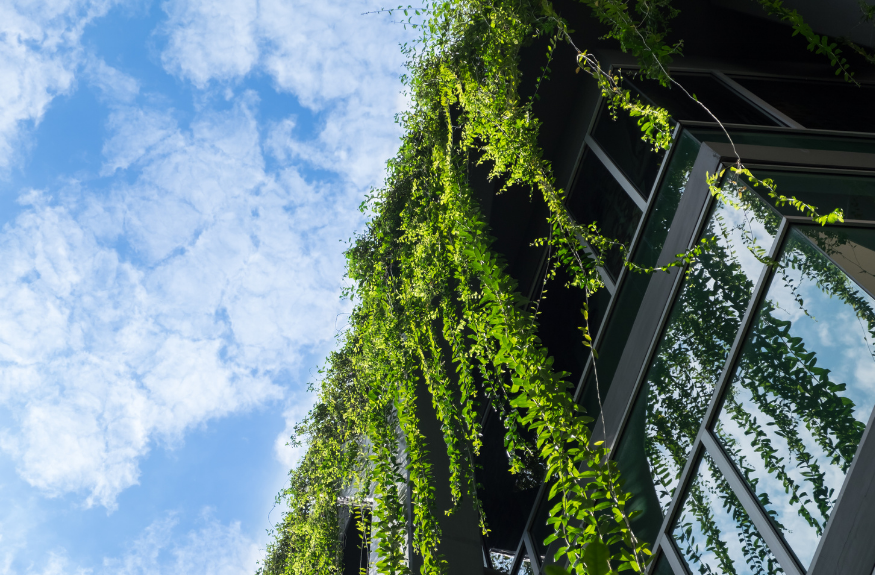5 Sustainable Landscaping Trends to Watch in 2022
Landscaping trends are always evolving, particularly trends that focus on sustainability and less maintenance. Staying up to date with these trends helps your commercial property cut costs and increase environmentally conscious practices for a more sustainable property.
Energy Efficient Landscaping
Strategically planted trees can provide shade for buildings and serve as a blockade against the sun and lower cooling costs for building owners and managers. On the opposite side, trees grouped strategically called “windbreakers” provide a barrier between a building and powerful winds during colder months.
Outdoor lighting in landscaping is an attractive amenity for tenants while keeping bright and safe lighting. With LED lighting you can save money on energy costs. Solar energy is another sustainable option for cost-effective lighting to enhance a landscape and with decreases in solar cell costs, a solar install may be cheaper than ever.
According to Schill Grounds Management, a professional landscaping management company in Ohio, another way to increase sustainability and save on costs is to update irrigation systems to reflect the latest technology like rain sensors and sprinkler timers. Newer technologies in irrigation systems allow for less water use and less maintenance time.
Outdoor Amenities
“Many things are being put in and designed to keep people at the properties to utilize the space, and I think a very important selling point for a leasing or management company when they’re trying to attract people” says Mary Kay Woodworth, Executive Director of the Urban Agriculture Council.
Woodworth mentions outdoor amenities like patios, rooftop gardens, bocce ball courts, and more that she’s seen recently added to commercial property planning.
“There’s been research to show that if you provide a very beautiful and comfortable environment for the office workers that they’ll stay there and they’ll work harder” Woodworth adds.
Higher retention rates and interest from potential tenants are major benefits to various outdoor amenities. Added amenities like outdoor kitchens, patios, rooftop gardens, and more attract new tenants and maintain current ones.
Xeriscaping and Water Management
Xeriscaping is a form of landscaping that uses little to no water, which reduces costs on irrigation systems and water. Xeriscaping primarily utilizes native plants which are more drought-resistant in their native climates eliminating the need for expensive irrigation systems. This method of landscaping also reduces maintenance costs.
Landscaping professionals are moving towards more water efficient plants like native species to cut down on management costs and maintenance. Sustainable water management in landscaping can look different for different properties, such as grey water reclamation systems or an onsite well to reduce water costs.
“Water management is something that really makes a big difference because it’s not just about watering your lawn. It’s all about the storm-water runoff and pesticide use and things like that” says Woodworth.
Education on water management and conservation for landscaping professionals and commercial property stakeholders is an important preparation tool in the event of a drought or other unforeseen issues.
Technology
Recently, landscaping and agriculture professionals began utilizing drone technology.
“Drones have technology in them that can measure and observe properties from incredible angles. They can be up above the properties and locate water issues and insect or disease issues. Drones really help pinpoint problems on the property, and they are much more efficient and comprehensive than a person walking the property” explains Woodworth.
Drones have allowed landscape planning to become more efficient and faster than traditional surveying techniques, but automation in commercial landscaping doesn’t end there.
Automated lawn mowers have also become popular in recent years. They reduce labor costs, noise, and are more efficient than traditional mowers.
“Technology has made a tremendous difference and will continue to do so, particularly in commercial properties where you’ve got vast properties with many, many different topography, terrain, shade, and sun situations,” says Woodworth.
Vertical Landscaping
Vertical landscaping is when plants are placed in a supporting structure vertically and grow directly on said structure. Some vertical landscaping systems include built in irrigation systems for lower maintenance. Living green walls in commercial properties are becoming increasingly popular for added greenery.
Living walls are structures affixed on a wall with a self-sufficient vertical plant system. These green walls are an interesting amenity for tenants and have the added benefit of improving air quality and adding aesthetically pleasing elements to a commercial property.
Potted plants are another great way to increase air quality and improve aesthetics in a commercial property with low maintenance costs.
These trends and tactics can make your property more sustainable while simultaneously reducing costs. Keeping up with current sustainable trends help makes your property the most efficient and environmentally conscious it can be. Implement some of these trends in your property today!
Want to know more about landscaping in CRE? Check out the Commercial Real Estate Landscaping Guide to read more articles on xeriscaping, water features, and more.
To stay up to date on news and resources such as this and other topics of importance to the real estate industry, subscribe to the free CRE Insight Journal Newsletter using this link.
Sources:
Mary Kay Woodworth, Executive Director of the Georgia Urban Agriculture Council
What is Xeriscaping? – GroundMasters Landscape Services, Inc. (groundmastersls.com)
The Principles of Xeriscaping | Buildings
The Hottest Landscaping Trends for Commercial Properties (schilllandscaping.com)









